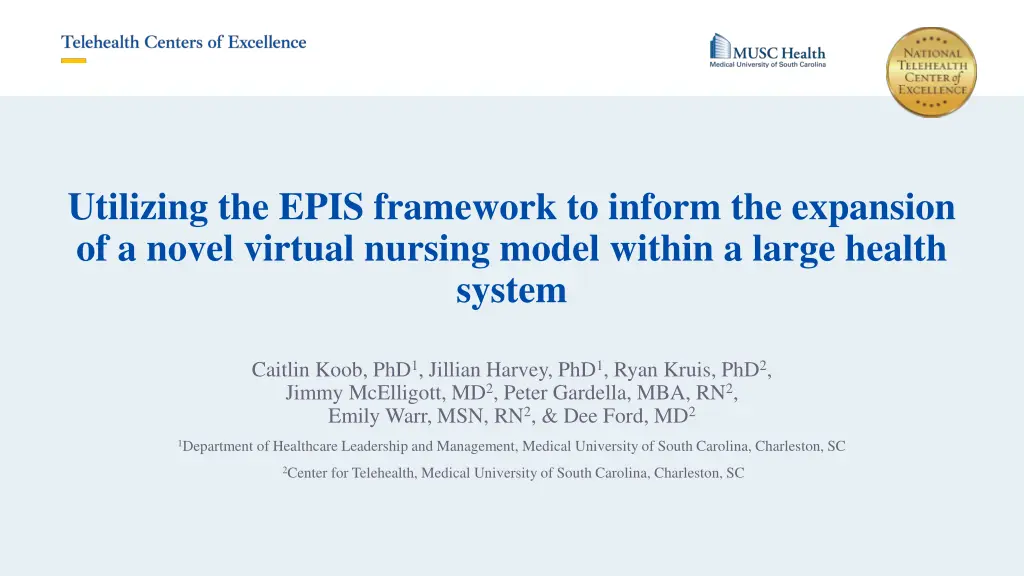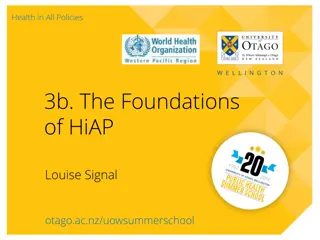
Innovative Virtual Nursing Model in Large Health System
Explore the implementation and expansion of a novel Virtual Nursing program within a large health system, leveraging remote nurses to support bedside care delivery. Addressing workforce challenges and improving patient outcomes.
Download Presentation

Please find below an Image/Link to download the presentation.
The content on the website is provided AS IS for your information and personal use only. It may not be sold, licensed, or shared on other websites without obtaining consent from the author. If you encounter any issues during the download, it is possible that the publisher has removed the file from their server.
You are allowed to download the files provided on this website for personal or commercial use, subject to the condition that they are used lawfully. All files are the property of their respective owners.
The content on the website is provided AS IS for your information and personal use only. It may not be sold, licensed, or shared on other websites without obtaining consent from the author.
E N D
Presentation Transcript
Utilizing the EPIS framework to inform the expansion of a novel virtual nursing model within a large health system Caitlin Koob, PhD1, Jillian Harvey, PhD1, Ryan Kruis, PhD2, Jimmy McElligott, MD2, Peter Gardella, MBA, RN2, Emily Warr, MSN, RN2, & Dee Ford, MD2 1Department of Healthcare Leadership and Management, Medical University of South Carolina, Charleston, SC 2Center for Telehealth, Medical University of South Carolina, Charleston, SC
Background The U.S. healthcare system aims for safe, effective, person-centered, efficient, and equitable care Workforce issues impact patient outcomes and costs COVID-19 intensified these challenges There will be an estimated deficit of 3.2 million healthcare workers by 2026 nationwide In one state, 39% of surveyed nurses reported intentions of leaving their job within one-year
To address these concerns, a Virtual Nursing (VRN) program was developed as an innovative care delivery model, leveraging teams of remote, virtual nurses to support bedside nurses in providing care via technology This presentation describes the implementation and expansion of a novel VRN model within a large healthcare system
MUSC Health Academic medical center Comprised of 2,744 beds, 750 care locations, and nearly 350 telehealth locations Operates 16 hospital locations across Charleston and 9 rural counties known as the MUSC Regional Health Network
Virtual Nursing Model An innovative, hybrid care delivery model Leverage teams of remote, virtual nurses to support bedside nurses in providing care via technology VRN services are delivered via mobile carts, which are allocated per unit VRN offset time-intensive tasks, allowing bedside nurses more time for patient care Following initial implementation in adult medical-surgical units, VRN services are deployed across several populations who include but are not limited to those with mental and behavioral health needs, those who are imprisoned, and children in inpatient settings Additional use cases for this VRN model and potential expansions to underserved populations will be explored this year
Methods Multiple data sources are triangulated for ongoing evaluation (from 10/2023- 04/2025), including: Electronic health records data for patient information and provider efficiency Program tracking within REDCap OurDay Report for workforce (i.e., staffing) metrics Hospital Consumer Assessment of Healthcare Providers & Systems (HCAHPS) is a standardized survey of patients perspectives of hospital care, capturing patients experience with admission, discharge, and communication with nurses. Primary outcomes of interest include: VRN utilization, service unit types, patient satisfaction, and workforce metrics Descriptive statistics are used to analyze quantitative data
Methods: The EPIS Framework The Exploration, Preparation, Implementation, and Sustainment (EPIS) framework is applied to iteratively and rigorously evaluate the implementation of evidence-based interventions Each EPIS phase is well-structured to provide dynamic, real-time feedback, guide data- driven decisions, and evaluate program resources, activities, and outcomes
Results: Evaluating VRN Model Exploration Alleviate strained nursing- to-staffing ratios Offer remote opportunities for nurses Support retention Preparation Financial investments Engagement with nursing leadership Sustainability Proportion of services requested by floor Patient satisfaction Nurses perceptions Implementation VRN utilization: patients served, service units, service delivery Time given back to nurses
Implementation Breakdown of VRN Care by Service Type Admission tasks Expanded from 5 to 36 units in FY2025 Continue to go live in 2-3 new units 52.4% per month Quality surveillance Discharge tasks 36.2% 10.6% Through 4/1/2025, VRN provided 29,463 service units among 20,578 patients Care plan management 0.42% To date (as of 4/1/2025), 14,942 hours Documentation 0.31% (622.6 days) were given back to Education 0.03% bedside nurses through VRN support
Sustainability In March 2025, 94.7% of VRN services were requested by the floor unit Improved patient experiences in all units with VRN Turnover rates remained stable or decreased across VRN units, indicating VRN model supports retention
Discussion Technology provides an opportunity to improve healthcare access and quality, while also reducing the burden placed on healthcare providers that often leads to burnout Despite its promising results thus far, VRN remains an innovative approach to improve healthcare service delivery for patients, improve provider-level outcomes to alleviate healthcare workforce issues (i.e., engagement, turnover rates), and potentially support the financial viability of health systems Still, there is limited evidence of the impact of VRN models nationally, beyond general acceptability and feasibility among bedside nurses
Discussion & Next Steps National efforts to address gaps related to healthcare access, quality, and workforce have elicited little success SC is particularly vulnerable as its rural hospitals may be permanently affected by employee shortages and become at high risk of closure Considering value in different use cases of VRN model Ongoing efforts to evaluate the impact of VRN on measures including, but are not limited to: Differences in perceived value of VRN among bedside and virtual nurses Patient-level outcomes, including patient satisfaction and infection rates by unit Provider-level metrics, such as turnover rates, nurse-to-patient ratios over time, and medication errors by unit System-level financial health (i.e., staffing with contract nurses) and application of findings analyze to national administrative datasets This study is part of the Telehealth Centers for Excellence at the Medical University of South Carolina. Scan the QR code to learn more about this program and others.
Questions? Please feel free to reach out to Caitlin Koob at cak240@musc.edu. Thank you! This presentation was made possible by the Health Resources and Services Administration (HRSA) of the US Department of Health and Human Services (HHS) as part of the National Telehealth Center of Excellence Award (U66 RH31458). The contents are those of the author(s) and do not necessarily represent the official views of, nor an endorsement, by HRSA, HHS or the US Government.





















